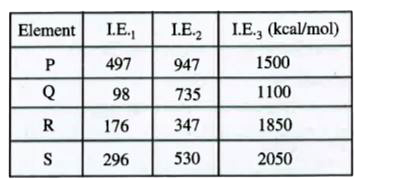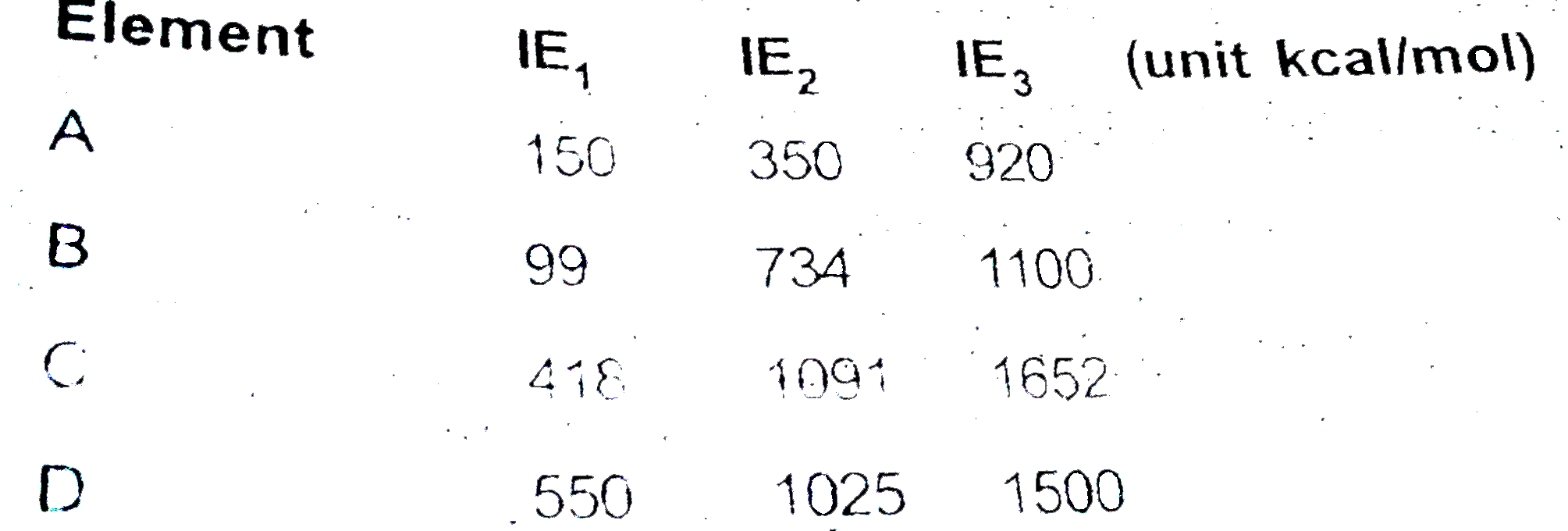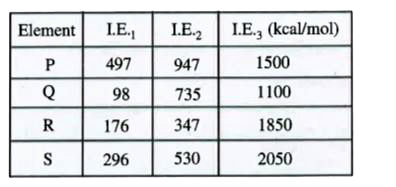Ionization potential is the minimum amount of energy needed to remove the outermost electron from the gaseous isolated atom. Its unit is eV/atom or kJ/mol. Successive ionization energy is the amount of energy needed to remove electron successively from a gaseous ion, it may be termed as I.E.2,I.E.3, .... The difference in the values of I.E.1,I.E.2, . helps to determine electronic configuration of the elements.

Which of the element can make MX type compound (X is the halogen)?Solution in Telugu
P
Q
R
S
The correct Answer is:B
Step by step video & image solution for Ionization potential is the minimum amount of energy needed to remove the outermost electron from the gaseous isolated atom. Its unit is eV/atom or kJ/mol. Successive ionization energy is the amount of energy needed to remove electron successively from a gaseous ion, it may be termed as I.E._2, I.E._3, .... The difference in the values of I.E._1, I.E._2, . helps to determine electronic configuration of the elements. Which of the element can make MX type compound (X is the halogen)? by Chemistry experts to help you in doubts & scoring excellent marks in Class 11 exams.
Updated on:21/07/2023Topper's Solved these Questions
- PERIODIC PROPERTIESBOOK - AAKASH SERIESCHAPTER - PERIODIC PROPERTIESEXERCISE - LEVEL-II (TYPE-I) (LECTURE SHEET-3 (MATCHING))
1 Videos
- PERIODIC PROPERTIESBOOK - AAKASH SERIESCHAPTER - PERIODIC PROPERTIESEXERCISE - LEVEL-II (TYPE-I) (PRACTICE SHEET-3 (MORE THAN ONE CORRECT ))
5 Videos
- PERIODIC PROPERTIESBOOK - AAKASH SERIESCHAPTER - PERIODIC PROPERTIESEXERCISE - LEVEL-II (TYPE-I) (LECTURE SHEET-3 (MORE THAN ONE CORRECT ))
5 Videos
- PERIODIC CLASSIFICATIONBOOK - AAKASH SERIESCHAPTER - PERIODIC CLASSIFICATIONEXERCISE - OBJECTIVE EXERCISE - 3 (RECENT AIPMT/NEET QUESTIONS)
14 Videos
- PERIODIC TABLEBOOK - AAKASH SERIESCHAPTER - PERIODIC TABLEEXERCISE - EXERCISE ON PASSAGE
12 Videos
Similar Questions
Match the following

View SolutionWhich of the following statement is(are) correct ?
View SolutionWhich of the following statements are correct ?
View SolutionWhich one of the following orders is not in accordance with the property stated against it?
View SolutionPASSAGE - 1: In Mendeleeff's periodic table elements were classified on the basis of atomic weight & in modern periodic table on the atomic number. The lighter elements of 2 & 3 periods show similarities in their properties called diagonal relationship
1. Which of the following element is not present in Mendeleeff's periodic table
View SolutionThe removal of an electron from which gaseous atom requires the greatest amount of energy?
View SolutionIonisation energy is the amount of energy required to remove the outermost e− from a gaseous atom. It's unit is kJ/mole or kcal/mole.
Successive ionisation energy - It is the amount of energy required to remove electron successively from a gaseous ion. These are termed as IE2,IE3,IE4 etc. the difference in the values of IE1,IE2 and IE3 helps to determine electronic configuration of the element.

Which element forms stable unipositive ion ?
View SolutionIonisation energy is the amount of energy required to remove the outermost e^(-) from a gaseous atom. It's unit is kJ/mole or kcal/mole. Successive ionisation energy - It is the amount of energy required to remove electron successively from a gaseous ion. These are termed as IE_(2), IE_(3), IE_(4) etc. the difference in the values of IE_(1), IE_(2) " and " IE_(3) helps to determine electronic configuration of the element. Which of the following is a non-metal ?
View SolutionIonisation energy is the amount of energy required to remove the outermost e− from a gaseous atom. It's unit is kJ/mole or kcal/mole.
Successive ionisation energy - It is the amount of energy required to remove electron successively from a gaseous ion. These are termed as IE2,IE3,IE4 etc. the difference in the values of IE1,IE2 and IE3 helps to determine electronic configuration of the element.

Which element is a noble gas ?
View SolutionThe amount of energy required to remove an electron from the last orbit of an isolated (free) atom in gaseous state is known as ionization potential or first ionization potential of the element. Similarly, the energy required for the removal of the electron from the unipositive ion (produced above) is referred to as second ionization potential and thus the third, fourth etc. lonization potentials may be defined in general as the number of ionization potentials of an element may be as much as its number of electrons.
The realationship between IE3andIE1 of element is
View SolutionThe amount of energy required to remove an electron from the last orbit of an isolated (free) atom in gaseous state is known as ionization potential or first ionization potential of the element. Similarly, the energy required for the removal of the electron from the unipositive ion (produced above) is referred to as second ionization potential and thus the third, fourth etc. lonization potentials may be defined in general as the number of ionization potentials of an element may be as much as its number of electrons. Which of the following statemetn is correct ?
View SolutionThe amount of energy required to remove an electron from the last orbit of an isolated (free) atom in gaseous state is known as ionization potential or first ionization potential of the element. Similarly, the energy required for the removal of the electron from the unipositive ion (produced above) is referred to as second ionization potential and thus the third, fourth etc. lonization potentials may be defined in general as the number of ionization potentials of an element may be as much as its number of electrons. Ionization energy increases on moving down a group due to
View SolutionThe amount of energy required to remove an electron from the last orbit of an isolated (free) atom in gaseous state is known as ionization potential or first ionization potential of the element. Similarly, the energy required for the removal of the electron from the unipositive ion (produced above) is referred to as second ionization potential and thus the third, fourth etc. lonization potentials may be defined in general as the number of ionization potentials of an element may be as much as its number of electrons.
Ionization energy of nitrogen is more than that of oxygen which can be explained by
View SolutionIonization potential is the minimum amount of energy needed to remove the outermost electron from the gaseous isolated atom. Its unit is eV/atom or kJ/mol. Successive ionization energy is the amount of energy needed to remove electron successively from a gaseous ion, it may be termed as I.E.2,I.E.3, .... The difference in the values of I.E.1,I.E.2, . helps to determine electronic configuration of the elements.

The order of ionic mobility in aqueous solution of the following ions will be (If R, S belong to same group):
View SolutionThe ionization potential of hydrogen atom is 13.6 eV. The energy required to remove an electron from the n=2 state of hydrogen atom is:
View Solution
